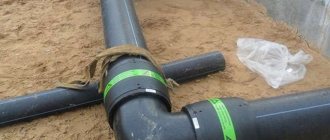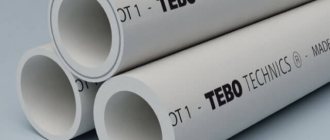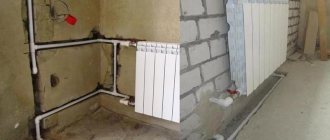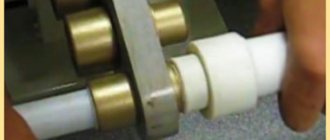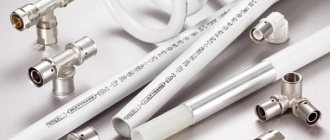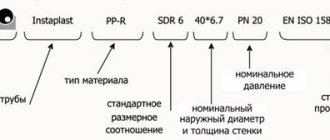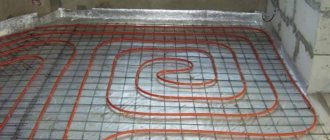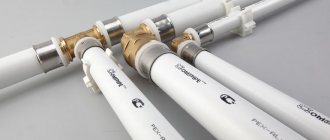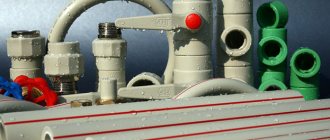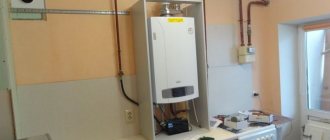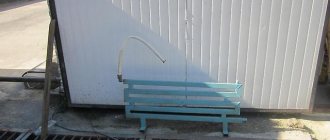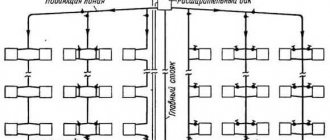Home / Welding technique
Back
Reading time: 3 min
0
592
The topic of pipe welding is very broad and complex. Mainly due to the fact that stores offer a large number of blanks. There are many types of pipes in diameter and material.
They can be wide, narrow, plastic, steel or alloys. Pipe material is only one of the parameters important for choosing a welding method and technique.
For gas supply, for example, pipes made of different steels are used. And in order to create a gas pipeline structure, you need to have experience and an understanding of the basic rules of the welding process.
Beginners will not be able to weld such pipes on their own; this is a task for experienced welders. If you have long mastered various methods of creating structures and several types of welding, you will be able to install a gas system in your home.
What techniques are needed in this case, and how to weld a gas pipeline yourself? We'll tell you in this article.
- general information
- Safety precautions
- Argon arc welding
- MIG and MAG welding
- Gas welding
- Welding gas pipes in an apartment
- Conclusion
general information
Which technology to choose? Argon arc welding, inverter MIG/MAG and gas welding are suitable for gas pipes.
There are also production technologies that include large-scale automatic equipment and have high productivity on an industrial scale.
We are talking about home welding here, and we don’t need the features of conveyor production. The technologies that we listed before will just help you weld gas pipes in a residential area.
There is no ideal welding technique. Each of them can be viewed from both the “light” and “dark” sides. We will not recommend any of them by calling them “the best.”
It all depends on the thickness of the walls of your pipes, their diameter, and the type of steel from which the pipes are made. In some cases, work sites are difficult to reach, and this must also be taken into account when choosing a technology.
In any case, before soldering, free the edges of the pipes from paint, dust and rust. Afterwards you need to cut them if they are thicker than six millimeters.
The type of cutting is selected depending on where the pipe will be located in the structure.
The creation of a gas pipeline must be approached responsibly. If the seams oxidize, crack, or simply do not have sufficient sealing, a leak will occur on the first day of using the system.
This increases the risk of poisoning, fire or even explosion in the apartment. To avoid these consequences, you must first of all not skimp on consumables. But it is also important to study the welding method you need and its nuances.
Gas pipe welding: technology review
The technology for welding gas pipeline elements depends on the structural material used in the pipe manufacturing process. And since only two types of pipes are used in the gas industry: metal and polymer, welding of such pipelines can be, respectively, electric arc, plasma (gas), argon arc or diffusion.
Moreover, each technology is used in specific conditions - depending on the thickness of the pipe walls, the type of steel or plastic, the outer diameter of the pipeline, and so on. Therefore, further in the text we will consider aspects of the application of technologies for joining steel and polymer products.
Safety precautions
Welding work is dangerous, so read the safety rules before you begin. Processing gas systems is unsafe for the health of the welder, so the rules should not be neglected.
Rule #1. Do not open gas cylinders suddenly. They have built-in oxygen reducers, which easily ignite when gas is suddenly supplied. The cylinder is under high pressure, so any incorrect movement can cause it to explode.
Argon arc welding
Argon arc welding (TIG) takes place in a gas environment. Its basis is a tungsten-coated electrode and an inert gas. Such electrode rods do not melt and do not take part in the formation of a connection between the elements.
They only accelerate the melting of the metal workpieces. The molten edges are connected to each other - this is the seam. Argon protects the welding zone from the influence of atmospheric gases (for example, oxygen) and prevents early oxidation.
TIG welding is good for welding pipes with thin walls. And to connect steel gas pipes, use direct current. The diameter of the rods you will need must match the cross-section of the pipe being welded.
What is gas welding
The basis of gas welding is the heating of metal sections with a flame formed by the combustion of a mixture of oxygen and flammable gas, and then filling the joint between the welded elements with molten metal. The strength of the weld seam during gas welding is lower than as a result of other types of welding (for example, electric arc), but when installing pipes of small diameter (up to 150 mm) or with thin walls (less than 3.5 mm), this is the only possible way to connect them.
MIG and MAG welding
The MIG/MAG method combines filler wire and a protective gas atmosphere.
The welder can feed the filler material into the weld pool manually, use a semi-automatic machine in which he controls only the feed rate, or use automatic equipment that controls the wire completely mechanized.
The first technology is the most economical option. Manual feeding of filler wire does not require expensive equipment with complex microcircuits and automation.
But this method is more difficult: manual application of the additive can be learned after months of practice.
Automatic equipment for MIG/MAG costs from five hundred dollars. This price did not come out of thin air. The machines handle most of the processes themselves.
The welder only lights the arc and leads it, creating a connection. Wire feeding and speed are fully automatic.
A semi-automatic welding machine is more versatile. It helps the welder deal with the additive, which makes the job easier. It costs less than an automatic one, but the quality of finished seams is not inferior to it.
In addition, the semi-automatic machine can be used for different steels: low-carbon, high-carbon, stainless steel and others.
The connection under such conditions is formed due to two factors: melting of the edges of the pipes and solder of the filler material. If you practice and learn how to use a semi-auto well, you will have a sealed gas design.
To do this, you also need to correctly install the supply from the gas cylinder. A gearbox will simplify the task. A little shielding gas is consumed, and no more should be consumed.
MIG/MAG welding
MIG/MAG welding is a method whose essence is the use of shielding gas and welding wire. This technology can be manual (when the welder himself feeds the wire into the weld pool), semi-automatic (when the wire feed is mechanized, but the welder still controls the feed speed) and automatic (when the wire is fed automatically at a given speed).
The simplest and most inexpensive option is welding using shielding gas and manual wire feeding. You don't need to have expensive semi-automatic or automatic wire feeding equipment. But here you need to have experience, since feeding wire by hand is not easy.
Automatic welding is good for everyone. She feeds the wire herself, and all you have to do is conduct the arc. But the equipment for automatic welding is expensive, and you’re unlikely to want to buy a $500 machine to fix a gas pipe in the kitchen.
Therefore, we recommend that you choose to buy a semi-automatic machine. This is a universal device. On the one hand, it helps you feed the wire, so it will be easier for beginners. On the other hand, it is not that expensive, but it allows you to achieve good quality seams. Using a semi-automatic machine, you can weld pipes made of low-alloy or high-alloy steel.
Here the seam will be formed not only by the molten metal, but also by the wire. So the connection quality will be good if you know how to handle a semi-automatic device. Do not forget that you need to adjust the supply of shielding gas from the cylinder. For this you can use a gearbox. And watch the consumption of shielding gas when welding, it should not be too high. For example, when welding a thin-walled pipe using carbon dioxide, it can take up to 15 liters, and this is normal.
Gas welding
When joining metals in this case, a special wire, oxygen and ethylene, a colorless flammable gas, are used. It burns and melts metal workpieces, and the combustion of this gas is supported by an oxygen environment.
With this technology, the seam will be loose and of worse quality than that of semi-automatic machines or arc welding with argon.
There will also be twice as many gas cylinders, whose supply needs to be controlled. This method is complex, so when starting work, you must be 100% confident in yourself.
The material of the wire must be the same as the metal of the pipes being connected. Reducers must be placed on both cylinders - with acetylene and oxygen.
Welding with MIG/MAG technology
According to the degree of mechanization, connecting pipes by electric welding is divided into manual, automatic and semi-automatic. The technology for connecting gas pipes MIG/MAG (Metal Inert/Active Gas) is based on arc welding using a metal consumable electrode (wire) in the presence of an inert/active gas. The filler wire is fed automatically.
This method is implemented by the following devices:
- inverter semi-automatic welding equipment;
- semi-automatic welding machine;
- a set of a consumable electrode supply mechanism and an arc welding source.
MIG/MAG welding is performed by feeding a metal wire with a gun into the joint area and melting it in an arc. It is located between the product and the consumable electrode. The molten wire and edges form a weld pool. The crystallizing seam, arc, weld pool metal and wire are protected by gas from environmental influences.
MIG/MAG welding involves the use of special wire
Often this method is also called semi-automatic, since the welder must manually move the torch along the seam. The wire is both a filler material and a conductive electrode.
Important! It is better to regulate the gas supply using reducers with flow meters.
The MIG/MAG method can be used to weld low and high alloy steels. The quality of an electric welded joint depends on the arc voltage, the feed rate of the consumable electrode, the gas feed rate and welding.
Welding gas pipes in an apartment
Knowing the features will help you both if you create a gas pipeline yourself, and if you want to monitor the work of hired craftsmen.
First, the gas supply in the apartment is shut off. This is the first rule that must be followed to avoid fire. If the employees have not done this, convincing you that “everything will be fine,” you should already be wary.
Small pipes can be handled by one person. If the pipes are of different cross-sections, you will need to buy several adapters to weld them. They will help prevent gas leaks. Pay attention to how tightly they are attached to the pipes.
To remove residual household gas from the pipes, they need to be purged. Then the steps are chosen based on what exactly you need to do.
If the pipes need to be routed to another location, a hole is drilled in them through which an outlet is welded to the system. Then a valve lever is connected to the outlet to regulate the gas supply.
How to check if there is a domestic gas leak in a gas pipeline? Most often this is done using a solution with liquid soap or any other foaming product. Apply it to the joint and wait a little.
If the solution produces bubbles in some places, gas will definitely flow in these places. In this case, the pipes must be welded again. If there are no leaks, you can reintroduce gas through the pipeline.
